小学英语课堂观察量表设计与实践
- 格式:ppt
- 大小:10.83 MB
- 文档页数:16
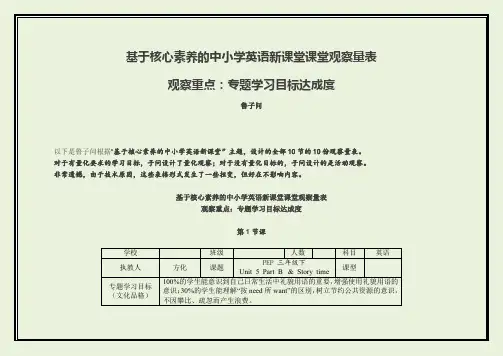
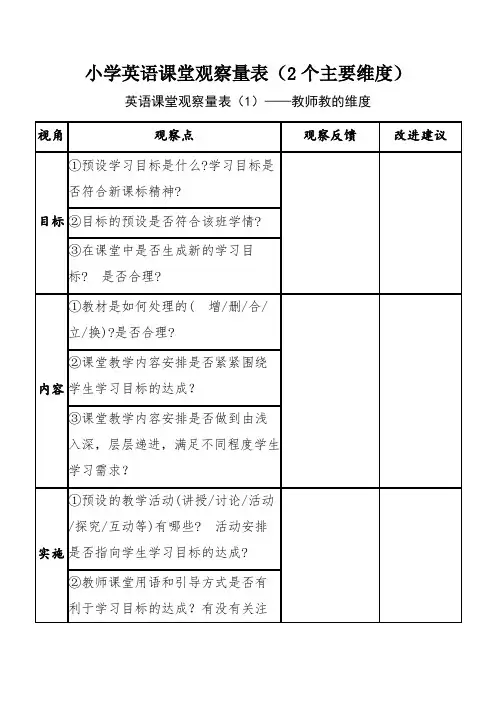
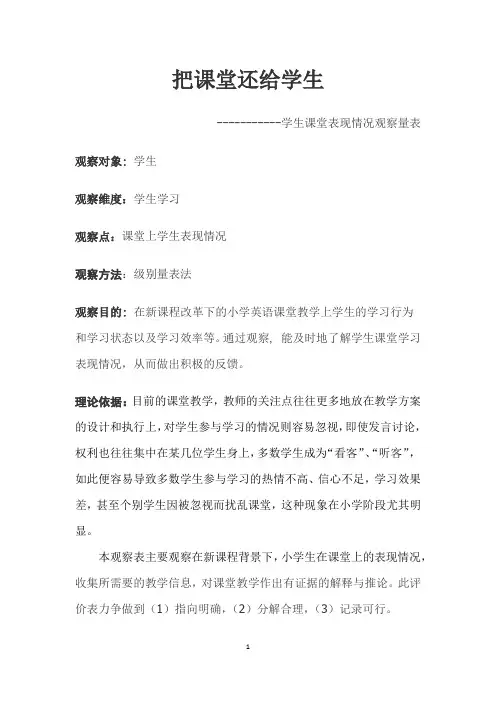
把课堂还给学生
-----------学生课堂表现情况观察量表观察对象: 学生
观察维度:学生学习
观察点:课堂上学生表现情况
观察方法:级别量表法
观察目的: 在新课程改革下的小学英语课堂教学上学生的学习行为
和学习状态以及学习效率等。
通过观察, 能及时地了解学生课堂学习表现情况,从而做出积极的反馈。
理论依据:目前的课堂教学,教师的关注点往往更多地放在教学方案的设计和执行上,对学生参与学习的情况则容易忽视,即使发言讨论,权利也往往集中在某几位学生身上,多数学生成为“看客”、“听客”,如此便容易导致多数学生参与学习的热情不高、信心不足,学习效果差,甚至个别学生因被忽视而扰乱课堂,这种现象在小学阶段尤其明显。
本观察表主要观察在新课程背景下,小学生在课堂上的表现情况,收集所需要的教学信息,对课堂教学作出有证据的解释与推论。
此评价表力争做到(1)指向明确,(2)分解合理,(3)记录可行。
学生课堂表现观察量表
设计意图及说明:本图表是围绕学生课堂上表现情况教学所设计的观察量表。
其中在效果一栏中,A表示效果很好;B表示效果一般;C 表示效果有难度;D表示效果不好。
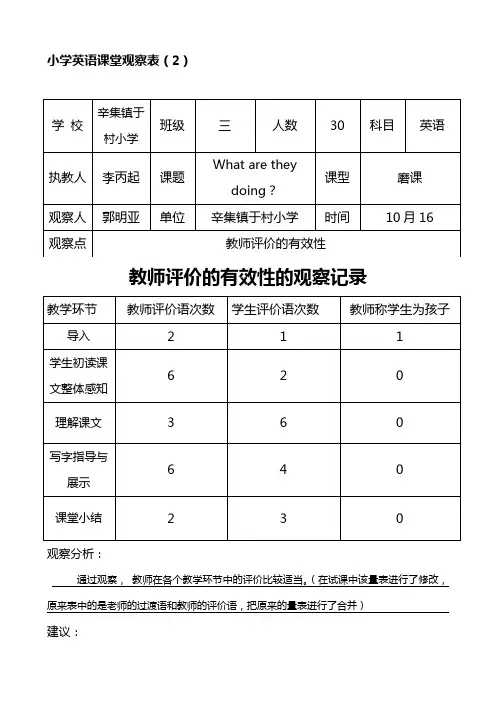
小学英语课堂观察表(2)
教师评价的有效性的观察记录
观察分析:
通过观察,教师在各个教学环节中的评价比较适当。
(在试课中该量表进行了修改,原来表中的是老师的过渡语和教师的评价语,把原来的量表进行了合并)
建议:
在与学生交流中称学生为孩子,这是一种不平等的交流,于永正和李家栋都曾说过,在课堂中称呼学生为孩子是一种不平等,希望教师在与孩子交流时尽量避免称呼学生为孩子等。
小学英语课堂观察表(3)
教学设计有效性的观察记录
观察分析:
在本节课中,采用了多种教学方式,激发了学生的学习兴趣,体现了中低年级教学的特点
建议:
小学英语课堂观察表(4)
教师提问艺术的观察记录
观察分析:
在教学中提出的问题既能抓住重点,又能做到关注面向全体学生,学生参与面广,在读词语环节学生参与面最广,问题难度小目标达成度高,在运用词语概括课文大意和对比蜗牛前后的不同时,问题有一定难度,学生参与不够积极。
在让学生运用词语表述课文大意时多给学生引导、提示来降低问题难度。
小学英语课堂观察表(5)
教学设计有效性的观察记录
小学英语课堂观察表(1)
教学设计有效性的观察记录。
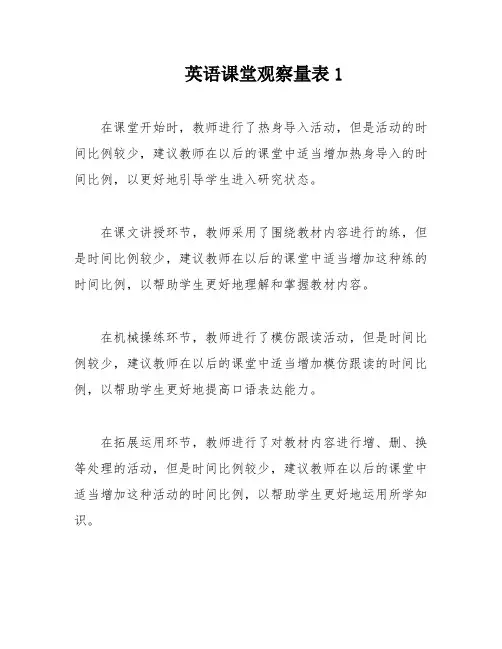
英语课堂观察量表1
在课堂开始时,教师进行了热身导入活动,但是活动的时间比例较少,建议教师在以后的课堂中适当增加热身导入的时间比例,以更好地引导学生进入研究状态。
在课文讲授环节,教师采用了围绕教材内容进行的练,但是时间比例较少,建议教师在以后的课堂中适当增加这种练的时间比例,以帮助学生更好地理解和掌握教材内容。
在机械操练环节,教师进行了模仿跟读活动,但是时间比例较少,建议教师在以后的课堂中适当增加模仿跟读的时间比例,以帮助学生更好地提高口语表达能力。
在拓展运用环节,教师进行了对教材内容进行增、删、换等处理的活动,但是时间比例较少,建议教师在以后的课堂中适当增加这种活动的时间比例,以帮助学生更好地运用所学知识。
在小结作业环节,教师进行了总结和布置作业,时间比例适当,建议教师在以后的课堂中继续保持这种时间比例,以帮助学生巩固所学知识。
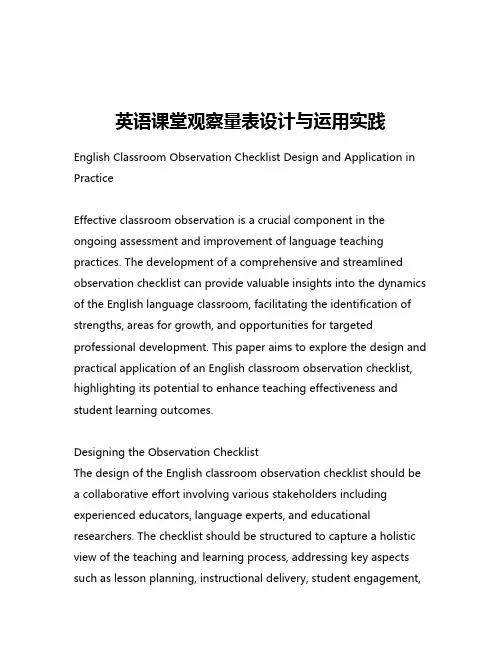
英语课堂观察量表设计与运用实践English Classroom Observation Checklist Design and Application in PracticeEffective classroom observation is a crucial component in the ongoing assessment and improvement of language teaching practices. The development of a comprehensive and streamlined observation checklist can provide valuable insights into the dynamics of the English language classroom, facilitating the identification of strengths, areas for growth, and opportunities for targeted professional development. This paper aims to explore the design and practical application of an English classroom observation checklist, highlighting its potential to enhance teaching effectiveness and student learning outcomes.Designing the Observation ChecklistThe design of the English classroom observation checklist should be a collaborative effort involving various stakeholders including experienced educators, language experts, and educational researchers. The checklist should be structured to capture a holistic view of the teaching and learning process, addressing key aspects such as lesson planning, instructional delivery, student engagement,and classroom management.Lesson PlanningEffective lesson planning is the foundation for a successful English language classroom. The observation checklist should assess the teacher's ability to design coherent and well-structured lessons that align with the curriculum objectives and the learners' needs. Indicators to be considered may include the clear articulation of lesson objectives, the selection of appropriate learning activities and resources, and the incorporation of differentiated instruction to cater to diverse learner profiles.Instructional DeliveryThe observation checklist should evaluate the teacher's ability to effectively deliver the lesson content, utilizing a range of instructional strategies and techniques. Aspects to be assessed may include the teacher's use of the target language, the clarity and organization of explanations, the integration of technology, and the effective use of questioning techniques to promote higher-order thinking skills.Student EngagementFostering active student engagement is crucial for optimal language learning. The observation checklist should examine the extent to which students are actively participating in the lesson, demonstratingtheir understanding through various forms of verbal and nonverbal responses. Indicators may include the teacher's ability to maintain student attention, encourage student-to-student interactions, and provide opportunities for learners to practice the target language.Classroom ManagementEffective classroom management is essential for creating a conducive learning environment. The observation checklist should assess the teacher's ability to establish and maintain clear classroom routines, manage transitions, and address any disruptive behaviors in a constructive manner. Indicators may include the teacher's ability to set and enforce expectations, respond to student needs, and promote a positive and inclusive classroom climate.Applying the Observation Checklist in PracticeThe effective application of the English classroom observation checklist requires a well-structured and collaborative approach. Observations should be conducted by trained and experienced observers, who can provide objective and constructive feedback to the teachers.Pre-Observation ConferencePrior to the observation, the observer should hold a pre-observation conference with the teacher to discuss the lesson plan, the specific areas of focus, and any contextual factors that may influence thelesson. This dialogue helps to establish a shared understanding of the observation process and sets the stage for a productive post-observation discussion.Observation and Data CollectionDuring the observation, the observer should carefully record their observations using the structured checklist, making note of specific instances that exemplify the various indicators. This systematic data collection allows for a comprehensive and objective analysis of the teaching and learning dynamics.Post-Observation ConferenceFollowing the observation, the observer and the teacher should engage in a collaborative post-observation conference. During this discussion, the observer should provide constructive feedback, highlighting the strengths of the lesson as well as areas for improvement. The teacher should be encouraged to reflect on their own practice, identify areas for professional growth, and develop action plans for implementation.Ongoing Professional DevelopmentThe insights gained from the classroom observations should inform the design and implementation of targeted professional development opportunities for teachers. This may include workshops, coaching sessions, or peer-to-peer learning partnerships thataddress the specific areas for growth identified through the observation process.ConclusionThe design and application of an English classroom observation checklist can serve as a powerful tool for enhancing teaching effectiveness and improving student learning outcomes. By systematically capturing the various aspects of the teaching and learning process, the checklist can provide valuable data to inform instructional decision-making, professional development, and ultimately, the ongoing refinement of language teaching practices. Through a collaborative and structured approach to classroom observation, educators can continue to strive for excellence in the English language classroom.。
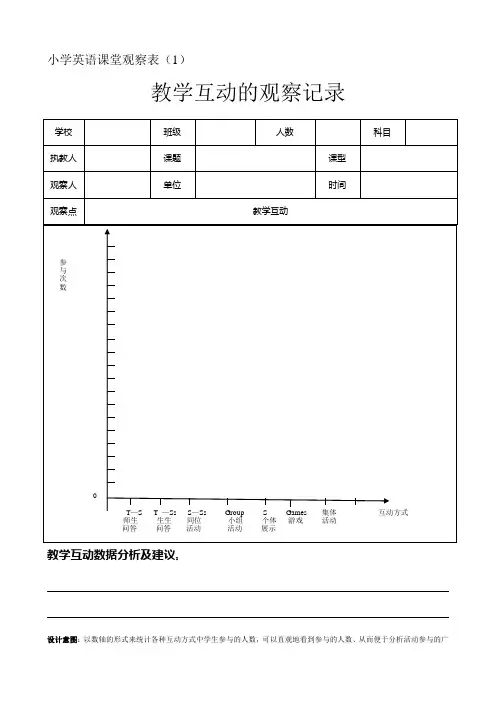
小学英语课堂观察表(1)教学互动的观察记录教学互动数据分析及建议:设计意图:以数轴的形式来统计各种互动方式中学生参与的人数,可以直观地看到参与的人数、从而便于分析活动参与的广度和有效性,互动方式可根据每节课具体情况添加记录。
观察记录与分析将有利于教师从学生对互动的反应及目标达成的指向性方面,更好的调整教学案,并有针对性的指导学生更有效地参与课堂学习活动。
小学英语课堂观察表(2)设计意图:本表主要记录学生参与课堂活动的整体情况。
记录学生发言的次数;一个方框代表一个学生,代表自愿回答,代表被动回答。
叫到一次,在其相应的位置上划相应符号,用“正”字纪录。
还可用符号“→”表示教师在教师里行走的路线图,从而正确反映出教师的顾及面。
通过数据可以看出教师设计的活动,是否能照顾到全体学生参与活动,活动的形式是否是多样的,而不仅仅是单一的活动,继而观察学生参与的效果,即学生的反馈。
同时需对活动的形式进行纪录,可总结出本堂课学生总共的活动,最后由观察教师提出相应的建议,以帮助授课教师更好地修改其教学活动,达到更好的教学效果。
小学英语课堂观察表(3)教师教学目标达成情况数据分析及建议:小学英语课堂观察表(4)教师语言的有效性的观察记录设计意图:教师语言的有效性,主要从教师过渡语、教师评价语、教师纠错三个方面进行观察,更明确的让教师知道自己在课堂中使用了哪些语言,哪些是有效的,哪些是无效的,根据情况进行调整,使内容目标明确、重难点突出;使学生对教师语言简单、易懂;使课堂顺畅、和谐。
小学英语课堂观察表(5)教学资源有效性的观察记录我的建议:设计意图:通过观察记录学生对老师所呈现的教学资源的反应,很明确的看出教学资源对学生的学习是否有帮助,也就是是否有效。
观察记录与分析将有利于教师从学生的反应及目标达成两方面,更好运用整合教学资源,在教学资源的选择上达到最优化。

运用课堂观察量表提高小学英语听评课有效性的探究【摘要】本文探讨了如何运用课堂观察量表提高小学英语听评课的有效性。
首先介绍了课堂观察量表在英语听评课中的作用,然后分析了小学英语听评课存在的问题。
接着提出了一种运用课堂观察量表的方法来提高听评课的有效性,并对实施效果进行评估。
最后讨论了不断完善提高听评课效果的策略。
通过本文的研究,可以有效提高小学英语听评课的质量,促进学生英语能力的提升。
未来可以进一步探讨如何结合其他评估工具和方法来提高听评课的效果,为英语教学改进提供更多的支持和帮助。
【关键词】小学英语,听评课,课堂观察量表,提高效果,探究方法,评估,完善,结论,展望未来1. 引言1.1 研究背景随着我国英语教育的不断发展,英语听评课在小学教学中越来越受到重视。
通过英语听评课,教师可以了解学生的英语听力水平,及时发现问题并对教学进行调整和改进。
在实际操作中,很多小学英语听评课存在着评估不准确、评价标准不明确等问题,导致评课效果不尽如人意。
为了提高小学英语听评课的评价准确性和有效性,有必要引入课堂观察量表来辅助评课工作。
课堂观察量表是一种系统化的评估工具,可以帮助教师全面观察课堂教学情况,并将观察结果量化,提高评价的客观性和科学性。
本研究旨在探讨运用课堂观察量表提高小学英语听评课有效性的方法,通过建立科学合理的评价体系,完善评课方法,进一步提高评课的准确性和有效性,促进小学英语听力教学的发展。
1.2 研究目的研究目的是为了探究如何通过运用课堂观察量表来提高小学英语听评课的有效性。
目前在小学英语教学中,听评课是评价教师教学效果的重要手段之一。
由于缺乏科学、客观的评价标准,使得听评课结果的准确性和可靠性存在一定的挑战。
本研究旨在通过运用课堂观察量表,建立更为科学、全面的评价体系,提高听评课的评价效果和指导效果,从而促进小学英语教学水平的提升。
通过本研究,希望能够为小学英语听评课的改进提供一定的参考和借鉴,提升教师的专业水平,促进教学质量的提高。

小学英语课堂观察表(2)
教师评价的有效性的观察记录
观察分析:
通过观察,教师在各个教学环节中的评价比较适当。
(在试课中该量表进行了修改,原来表中的是老师的过渡语和教师的评价语,把原来的量表进行了合并)
建议:
在与学生交流中称学生为孩子,这是一种不平等的交流,于永正和李家栋都曾说过,在课堂中称呼学生为孩子是一种不平等,希望教师在与孩子交流时尽量避免称呼学生为孩子等。
小学英语课堂观察表(3)
教学设计有效性的观察记录
观察分析:
在本节课中,采用了多种教学方式,激发了学生的学习兴趣,体现了中低年级教学的特点
建议:
小学英语课堂观察表(4)
教师提问艺术的观察记录
观察分析:
在教学中提出的问题既能抓住重点,又能做到关注面向全体学生,学生参与面广,在读词语环节学生参与面最广,问题难度小目标达成度高,在运用词语概括课文大意和对比蜗牛前后的不同时,问题有一定难度,学生参与不够积极。
在让学生运用词语表述课文大意时多给学生引导、提示来降低问题难度。
小学英语课堂观察表(5)
教学设计有效性的观察记录
小学英语课堂观察表(1)
教学设计有效性的观察记录
观察分析:
综合上表,本节课整体感知环节较长,单词的指导与展示环节相对较少,学生展示的空间小,没有达到共同提高的目的。
建议:
通过本节观察,建议初读课文、整体感知环节缩短用时,将时间分配到写字指导展示中,教师进行示范书写,效果更佳。

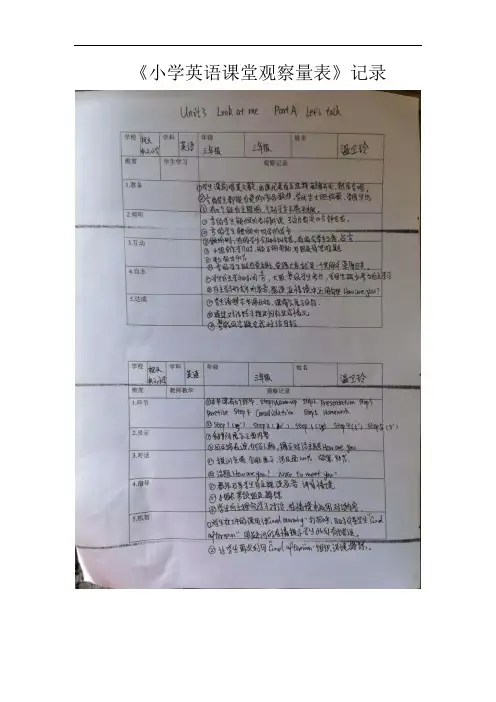
《小学英语课堂观察量表》记录《小学英语课堂观察量表》分析优点:(1)常规英语课,该教师上课善于组织理答,进行归纳。
这样有利于学生更好的掌握所学内容,这一点,我感觉是值得我在以后的教学中学习和借鉴的。
(2)课堂秩序良好,师生互动频繁,对于教学目标中知识与技能:理解并运用句型“How are you?”“I’m fine,thank you.”。
落实的很到位。
教师情境教学,开火车,小组合作等方式让学生加强印象,值得借鉴。
(3)教师范读,在范读的过程中不断指导,并且不时的点评人物的语气,加以动作示范,很是到位。
除此之外,对于语音语调的讲解很到位,指导学生在写朗读的过程中注意。
问题:(1)教师在授课的过程中,虽然整节课教师在课堂引领以及理答方面处理的很流畅,但是从总体数据来看的话,目标性理答,诊断性理答以及激励性理答中简单理答占据70%,存在唯知识主义倾向,没有更加关注学生的思维发展,我们要知道,英语的学习除了知识点的掌握之外,还有其他更值得教师指导给学生的。
因此教师在课堂理答中应该多运用发展性理答。
通过表格我们可以看出,教师代答的比较偏高,这就需要我们反思,教师是否可以稍微放手让学生自行解决,给与学生足够的时间去思考,而不是教师代替学生回答,适当地把课堂教给学生,发挥学生的主动性与创造性。
(2)教师对学生的理答存在片面倾向。
通过上文的数据可以得知,该教师在课堂中较多地使用直接反馈。
学生反馈较少,该结果表明,这表示学生并没有在课堂中接受全面的思维训练。
然而,该教师并没有认识到这一点,从而导致了理答的片面倾向。
我认为,小学英语教师应该经常观摩其他教师的授课,积累经验并锻炼自己的随机应变能力,这样才能在课堂教学中积极使用发展性理答。
(3)整个课程重点在于操练句型,其他方面没有涉及。
教师在课堂中根据教师的引导,学生自主学习操练句型。
小学英语学科课堂观察记录表
背景
为了更好地了解小学英语课堂的教学情况,我们需要进行观察和记录。
本文档提供了一个观察记录表,以帮助您记录课堂中的重要细节和观察结果。
观察记录表
观察记录表说明
1. 日期: 记录观察的日期,便于整理和比较不同时间段的课堂教学情况。
日期: 记录观察的日期,便于整理和比较不同时间段的课堂教学情况。
2. 课堂环境: 描述课堂环境的特点,如教室布置、学生座位等。
课堂环境: 描述课堂环境的特点,如教室布置、学生座位等。
3. 教学内容: 记录教师在该次课堂上所讲授的主题或具体内容。
教学内容: 记录教师在该次课堂上所讲授的主题或具体内容。
4. 教学方法: 记录教师在该次课堂中所采用的主要教学方法,
如讲解、示范、互动等。
教学方法: 记录教师在该次课堂中所采用
的主要教学方法,如讲解、示范、互动等。
5. 学生表现: 记录学生在该次课堂中的表现,如参与度、理解
能力、课堂纪律等。
学生表现: 记录学生在该次课堂中的表现,如
参与度、理解能力、课堂纪律等。
使用建议
- 在每次观察中,尽量详细记录对每个方面的观察结果和感受。
- 注意观察教师的教学方式和学生的反应,以评估教学效果。
- 对于观察中的重要发现或问题,可以在备注部分进行补充说明。
- 观察记录可用于后续分析和总结,以进一步改进教学质量。
备注
请根据观察实际情况灵活使用观察记录表,并随时更新和完善表中的内容。
小学英语课堂观察表(共五个)
小学英语课堂观察表(1)
教学互动的观察记录
教学互动数据分析及建议:
设计意图:以数轴的形式来统计各种互动方式中学生参与的人数,可以直观地看到参与的人数、从而便于分析活动参与的广
度和有效性,互动方式可根据每节课具体情况添加记录。
观察记录与分析将有利于教师从学生对互动的反应及目标达成的指向性方面,更好的调整教学案,并有针对性的指导学生更有效地参与课堂学习活动。
小学英语课堂观察表(2)
设计意图:本表主要记录学生参与课堂活动的整体情况。
记录学生发言的次数;一个方框代表一个学生,代表自愿回答,代表被动回答。
叫到一次,在其相应的位置上划相应符号,用“正”字纪录。
还可用符号“→”表示教师在教师里行走的路线图,从而正确反映出教师的顾及面。
通过数据可以看出教师设计的活动,是否能照顾到全体学生参与活动,活动的形式是否是多样的,而不仅仅是单一的活动,继而观察学生参与的效果,即学生的反馈。
同时需对活动的形式进行纪录,可总结出本堂课学生总共的活动,最后
由观察教师提出相应的建议,以帮助授课教师更好地修改其教学活动,达到更好的教学效果。
小学英语课堂观察表(3)
李沧区实验小学英语课堂观察表
教师教学目标达成情况。
运用课堂观察量表提高小学英语听评课有效性的探究【摘要】本研究旨在探讨如何运用课堂观察量表提高小学英语听评课的有效性。
通过对课堂观察量表的设计与应用、小学英语听评课的特点分析以及运用量表提高听评课有效性的方法探究,本文对实证研究和案例分析进行了深入分析。
研究发现,课堂观察量表对提高小学英语听评课的有效性起着重要作用,能够有效提升教学质量和学生学习效果。
未来的研究应该继续深入探讨课堂观察量表在英语听评课中的应用,为教学改革和提升教学质量提供更多有益的参考和建议。
通过本研究,可以为提高小学英语听评课的有效性提供理论支持和实践指导。
【关键词】小学英语,课堂观察量表,听评课,有效性,研究,方法探究,实证研究,案例分析,重要性,未来研究方向1. 引言1.1 研究背景研究背景:在小学英语教学中,听力是学生学习的重要环节。
而评价也是教学的关键环节之一。
在小学英语听评课中,教师可能会遇到一些挑战,比如如何准确评价学生的听力水平、如何有效提出建设性的反馈等。
为了解决这些问题,运用课堂观察量表对小学英语听评课进行指导和评价是一种有效的手段。
课堂观察量表可以帮助教师系统性、客观地记录学生的听力表现,提供数据支持,帮助教师更好地了解学生的听力水平,并针对性地进行反馈和指导。
对于小学英语教师来说,研究如何运用课堂观察量表来提高听评课的有效性具有重要意义。
本研究旨在探究运用课堂观察量表提高小学英语听评课有效性的方法,为教师提供更科学、更有效的教学评价手段。
1.2 研究目的研究目的是通过运用课堂观察量表来提高小学英语听评课的有效性,探讨如何更好地评估教师的教学效果,促进教学质量的提升。
具体包括以下几个方面:1. 探究教师在课堂教学中的具体表现,通过量化的数据来评估教学效果,帮助教师更好地了解自己的教学水平,发现不足之处,及时改进提高。
2. 借助课堂观察量表,通过系统记录和分析教学过程中的各种细节,为教学评估提供客观依据,减少主观因素的干扰,提高评价的准确性和公正性。
外语教学与研究2020.4浅谈小学英语教学中课堂观察量表的设计和应用◎林耀西课堂观察对改变教学方式与提升教学有效性具有重要意义,能够帮助教师对学生进行综合性的分析,在此基础上,便于教师有针对性地开展教学活动。
在小学英语教学中,教师应当对学生的课堂表现、学习状态、知识掌握情况等进行观察,便于及时地调整教学计划,促进学生的学习效率不断提升。
本文以下主要对小学英语教学中课堂观察量表的设计和应用进行了浅析。
1.课堂观察的运用在小学英语教学中,教师需要关注学生的学习感受,做好观察记录,对学生的学习实情进行综合性的分析,便于改善教学课堂,使学生有效地参与到学习之中。
课堂观察是一种教学研究的方法,是一种课堂观察的团队合作行为。
课堂观察量表在听课、评课教研活动中有重要的现实意义。
教师通过自己在课堂上的观察记录与评价综合量表中的某个特定维度。
在课后,依据个人的记录与评价与团队成员进行交流与研讨。
2.课堂观察的意义何在?课堂观察对开展针对性的教学活动具有辅助作用,能够让学生更高效地学习知识。
对于小学生而言,他们的自主意志力较为薄弱,需要教师做出针对性的指导,帮助他们明确学习目标,做到学习规划。
课堂观察可以让教师更好地了解学生,便于更好地开展教学活动,这对增强教学效果具有积极作用。
课堂观察可以促进教师不断反思自己,改进教育理念和教学行为,提升自己的教育教学能力,总结实践知识,汲取好的经验,改进自己教学的技能。
3.课堂中观察哪些内容?课堂观察的内容主要包括:学生学习情况;教师教学情况;课堂沟通与互动;课程资源的应用;课堂环境;课堂管理;教学常规落实情况,等等。
根据各类型课的观察指标,细化成具体的观察点。
小学英语教师在教学中,需要关注学生的学习状态,加强和学生之间的互动,了解学生的知识掌握情况,对学生不懂的地方着重进行讲解,以此提升教学的有效性。
如陕旅版小学英语教材五年级下册,第3单元Spring is coming.的A Let ’s learn 的教学,我们通过研究课程标准与教材,归纳小学单词教学课堂的几个关键点:单词认读、游戏教学、任务型教学,并按本节课的教学设计定制出初步的量表:“单词认读有效性”、“任务型教学”、和“游戏教学有效性”。
基于核心素养的中小学英语新课堂课堂观察量表观察重点:专题学习目标达成度以下是根据“基于核心素养的中小学英语新课堂”主题,设计的全部 10 节的10 份观察量表。
对于有量化要求的学习目标,子问设计了量化观察;对于没有量化目标的,子问设计的是活动观察。
非常遗憾,由于技术原因,这些表格形式发生了一些扭变,但好在不影响内容。
基于核心素养的中小学英语新课堂课堂观察量表观察重点:专题学习目标达成度第 1 节课学校班级人数科目英语执教人方化课题PEP 三年级下Unit 5 Part B & Story time课型专题学习目标(文化品格)100%的学生能意识到自己日常生活中礼貌用语的重要,增强使用礼貌用语的意识;30%的学生能理解“按need 所want”的区别,树立节约公共资源的意识,不因攀比、疏忽而产生浪费。
观察人单位时间专题目标学生课堂人次活动使用礼貌用语理解“按need 所want”树立节约意识不因攀比、疏忽而浪费问候导入学习活动 1 学习活动 2 学习活动 3 学习活动 4 学习活动 5 完成任务分析与建议(专本表记录学生开展本表所列活动次数。
用画“正”字方法记录,学生每开展一次,记录一次。
若为全体参与,则记录为100%。
第 2 节课学校班级人数科目英语执教人鲁子问课题《英语》(译林版)七年级下Unit 5 Reading课型专题学习目标(文化品格)100%的学生能在老师引导下初步感悟到以下品格的重要性:遇到疑惑不盲目猜测,努力发现真相;探寻真相时大胆但又谨慎的品格。
100%的学生能基于此为他人选择恰当的建议;30%的学生能基于此为他人提出建议。
观察人单位时间专题目感受“遇到疑惑不盲目猜测,努力发现真相”品格感受“探寻真相时大胆但又谨慎”品格基于感受为他人选择恰当基于感受为他人提出建议题学习目标达成度,方法有效性分析与建议)标学生课堂人次活动教师讲解************ ************学生思考************ ************同伴讨论全班分享教师点评************ ************分析与建议(专题学习目标达成度,方法有效性分析与建议)本表记录学生学习与运用所列词汇次数。